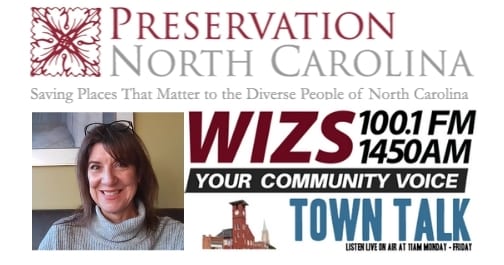Hosts Bill Harris and Mark Pace speak with Cathleen Turner, Piedmont Regional Director of Preservation North Carolina, about the importance of protecting historical properties.
Written story below.
As well, please enjoy full broadcast audio of the show.
Saving historic properties from demolition is but one aspect of Preservation North Carolina’s mission. The preservation of a physical building also keeps alive and relevant the stories that go along with the structure – its place in the community and the families that once lived or worked in them.
Cathleen Turner, Preservation North Carolina’s Piedmont regional director, said the nonprofit organization is a source of information for anyone interested in historic preservation – whether it’s restoration, repair or rehabilitation.
Turner was a guest on Town Talk Thursday and shared some of PNC’s success stories with hosts Bill Harris and Thornton Library’s Mark Pace.
It’s important to keep in mind whether a property is “saveable, buyable and sellable,” she said, as well as its role in the life of the community in which it’s located. “Sometimes the most modest little cottage can reveal a depth of information about the people who lived there or were associate with it.”
One success story has a local connection. Turner mentioned the Bellamy Mansion in Wilmington, a stewardship project of PNC. Pace noted that two Bellamy brothers married two sisters from right here in Vance County. The sisters were Hargroves, members of the family that owned Hibernia near Townsville. The Bellamy home fared far better than the Hargrove home, which is no longer standing. The Bellamy Mansion Museum of History and Design Arts took decades to rehabilitate, and it was turned over to PNC as a stewardship property in 1989.
Not all properties are destined to be restored to its original state, Turner said.
“We use the Secretary of the Interior standards for rehabilitation,” she said, “which are guidelines that we apply on a case-by-case basis.” Many of the buildings’ owners aren’t interested in restoring them to a particular period. “People like their indoor bathrooms and kitchens. And they like their Wifi, too,” Turner added.
The term “rehabilitation” may describe more accurately what occurs with properties. Updating to today’s standards is done thoughtfully, she said, “with respect to repair rather than replace.” If something is missing or beyond repair, then she recommends to replace in-kind. Yesterday’s materials – those old growth forest woods – are hardier than most modern materials. If the original materials can be saved, that is preferred. “The way we approach rehabilitation is very common-sense and sensible. And smart, from a bottom-line standpoint.”
Another success story is located in the tiny town of Milton, near the Virginia border. It is there that Thomas Day’s home and workshop have been restored. “We had been interested in seeing that building preserved for a very long time,” Turner said. A fire nearly burned it to the ground, but the building was not beyond restoration. She said it probably would have been razed had PNC not stepped in. Visitors can see where the famed furniture maker once lived and worked.
Closer to home is a property known as the Charles Brewer house, located on North Clark Street in Henderson. Houses located in National Register historic districts may be eligible for tax credits, Turner said. “We don’t give grants to private property owners,” she said, but tax credits provide incentives for the repair work and restoration to be completed.
Visit www.presnc.org to learn more about PNC’s projects and programs.
